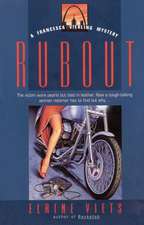The Pink Flamingo Murders
Autor Elaine Vietsen Limba Engleză Paperback – 30 iun 1999
The rehabilitation of North Dakota Place is a feel-good story--the kind St. Louis City Gazette columnist Francesca Vierling likes to write. Grand houses restored to former glory. Pride in a neighborhood--and, like all good stories, this one has a hero, the woman who made it all happen, the city's guardian of good taste. Some call her a rehabbing saint, others a fanatic.
The first death on North Dakota Place was certainly shocking but not entirely unwelcome--after all, the victim was a cranky old man who had been painting his house purple. The second death, of a drug dealer, brings tacit approval--and growing suspicion. But all bets are off when another victim is found, a socialite unceremoniously whacked with a pink lawn flamingo. Now the neighbors want Francesca to investigate. But her boyfriend wants her to commit to marriage, not crime. Soon the gutsy reporter is experiencing a deepening personal crisis--and something more heinous than vinyl siding: the dark secrets of heart, home, and blighted dreams.
From the Paperback edition.
Preț: 142.85 lei
Nou
Puncte Express: 214
Preț estimativ în valută:
27.33€ • 28.54$ • 22.57£
27.33€ • 28.54$ • 22.57£
Carte tipărită la comandă
Livrare economică 11-17 aprilie
Preluare comenzi: 021 569.72.76
Specificații
ISBN-13: 9780440613510
ISBN-10: 0440613515
Pagini: 272
Dimensiuni: 159 x 221 x 18 mm
Greutate: 0.36 kg
Editura: dell
ISBN-10: 0440613515
Pagini: 272
Dimensiuni: 159 x 221 x 18 mm
Greutate: 0.36 kg
Editura: dell
Notă biografică
A bona fide celebrity in her hometown of St. Louis, Elaine Viets was recently voted one of its five "most powerful" citizens by the Riverfront Times (ahead of Congressmen Thomas Eagleton and William Clay). In addition to writing two previous Francesca Vierling mysteries, Backstab and Rubout, she is the author of the humor book How to Commit Monogamy.
From the Paperback edition.
From the Paperback edition.
Extras
We approved of the first murder.
We applauded the second.
By the third murder, I think we would have given the killer a ticker-tape parade.
But the fourth death, that was different. Now the killer was going after one of our own. People like us.
By the fifth death, everyone was so frightened, they asked me to solve the crimes. I told them the police would do a better job. I said I'd never solved a murder. I told the truth, but no one believed me. Maybe if they had . . . well, it's too late for maybes now.
My name is Francesca Vierling, and I'm a columnist for the St. Louis City Gazette. I'm six feet tall, with dark hair, dark eyes, and a smart mouth. Or maybe not so smart, since it's always getting me in trouble. Today was one more example. If I'd just kept it shut and not answered the phone. There was no reason to answer it at seven-thirty at night. I should have left the office hours ago.
I was at the Gazette at the end of a steamy St. Louis summer day. Even with the air conditioner running full blast, there were heat pockets in the corners. My hair was flat and frizzed. My face felt like it was coated with vegetable oil. My summer suit was damp and crumpled. It was definitely time to go home. But as I was heading for the door, I picked up my ringing phone. My life began to unravel with one question:
"Hi, wanna go forking?" It was a woman's voice, with a smoky whiskey-and-cigarettes sound.
"Who is this?" I said. Did she say forking? Was that something obscene?
"You don't know me," she said.
"Certainly not well enough for what you proposed."
"It's not what you think," she said. Her laugh sounded like it had been rubbed with sandpaper, but it was oddly pleasant. "My name's Margie and I live in your neighborhood."
Forking, she swore, was the latest city fad. "You have to see it to believe it," Margie said. She wanted to show me. Margie sounded harmless. I'd have an easy column if I could be at her house on North Dakota Place, which was only two blocks from where I lived, by eight o'clock. I called Lyle, the man I almost live with, and canceled dinner for the second time this week. He didn't seem too unhappy. That should have made me suspicious, but I was eager to get to Margie's.
The heat hit me in the face when I walked out of the Gazette, but considering the rundown area, I was lucky that's all that hit me. The drive was so short, the car barely cooled off before I got home. I parked Ralph, my blue Jaguar, and walked over to Margie's street.
North Dakota Place was an almost grand boulevard, off not-so-Grand Avenue. A hundred years ago it had been one of the city's handsomest streets, on a par with Flora Place or Utah Place. The South Side of St. Louis was the blue-collar part of town, the old German section, the home of the Anheuser-Busch brewery. South Side places were not as extravagant as the West End private streets. They featured large homes rather than mansions. But they had been beautifully built by German craftsmen. Margie's house on North Dakota Place was typical. It was sturdy red brick and white stone with a gray slate roof. The stone porch was as big as a bungalow. I climbed Margie's stone steps, and pressed the old-fashioned brass doorbell. Margie answered on the first ring. Inside, the foyer was flooded with fiery golden light from a red-and-gold stained-glass window. It was twenty feet tall with a surreal tulip-and-peacock design, a turn-of the-century opium dream. The wide oak staircase had mellowed to a rich honey gold. Margie had piled the parson's seat with green velvet pillows that I'd seen on sale at Pier 1 Imports. In the large room off the foyer, I caught a glimpse of a dark fireplace mantel with hunter green tile, green paisley wallpaper, and a coffered ceiling.
I could also see that plants and clever picture arrangements were trying to hide wallpaper that was faded and peeling. The white molding needed paint, and there wasn't quite enough furniture to fill the vast room. Like most people on North Dakota Place, Margie had a little too much house and not quite enough money. I'd bet she was rehabbing the place one room at a time, and from the size of it, she had years of work ahead of her.
But Margie looked cheerful. She seemed to enjoy the challenge of being a rehabber. In St. Louis, that word meant more than someone who remodeled old homes. Most people associated rehabbing with saving someone from drugs or alcohol. St. Louis rehabbers saved houses. The city had some of the loveliest, and most unappreciated, architecture in the country. Few other cities let ordinary people live in such low-cost stately homes. Too bad the old homes were being torn down by the score in St. Louis. Each house saved became a small, personal victory. Rehabbers saved the city one home at a time. We needed more of them.
Margie was a big-boned, comfortable woman of forty or so, who looked at home in jeans and T-shirts. She combed her well-cut, shiny brown hair straight back, which emphasized her wide green eyes. She looked attractive and easygoing.
Forking, she explained, in that raspy voice I thought was so intriguing, meant covering a lawn with hundreds of white plastic forks, tines up.
"Why would anyone want to do that?" I asked.
"You have to see it to understand," she said. "That's why I called you."
She introduced me to her two helpers, Dina and Patricia. Patricia was tall and lean, with straight, smooth dark hair and serious eyes the color of new blue jeans. She sold what Margie called "earth-friendly products" out of her home, so I wasn't surprised that her T-shirt said "Earth Day 1997." She carried a beige canvas bag from a health food store filled with white plastic forks.
Dina was just the opposite: small, round, blond, and friendly. But I didn't want to underestimate her. Under that soft manner was one smart woman. She ran a successful PR consulting company out of her home on North Dakota Place. Dina had the professional woman's haircut, a soft wedge, that would have gone perfectly with a tailored suit. But she was wearing a "Love me, love my cat" T-shirt.
"How late are we going to be?" she said. "Stan likes to be fed at eight-thirty."
"Is Stan your husband?" I asked, wondering why a woman with so much going for her would be married to such a tyrant.
Margie laughed, a brash barroom bray, and said, "Stan's her cat. If Dina waited on men the way she waits on that hairy beast, she could have ten husbands."
Dina didn't seem offended by Margie's remark. "One husband was enough for me," she said. "I got rid of him for tomcatting, then got the real thing. My man Stan is handsome, affectionate, and intelligent. He never comes home drunk and never leaves the lid up on the toilet seat. He likes his dinner on time, but all I do is open a can. Couldn't serve meals like that to my ex." Dina went to a round inlaid table in the foyer and examined an Art Nouveau vase in a glimmering sea green and silver. "This is lovely," she said reverently. "How much?"We approved of the first murder.
We applauded the second.
By the third murder, I think we would have given the killer a ticker-tape parade.
But the fourth death, that was different. Now the killer was going after one of our own. People like us.
By the fifth death, everyone was so frightened, they asked me to solve the crimes. I told them the police would do a better job. I said I'd never solved a murder. I told the truth, but no one believed me. Maybe if they had . . . well, it's too late for maybes now.
My name is Francesca Vierling, and I'm a columnist for the St. Louis City Gazette. I'm six feet tall, with dark hair, dark eyes, and a smart mouth. Or maybe not so smart, since it's always getting me in trouble. Today was one more example. If I'd just kept it shut and not answered the phone. There was no reason to answer it at seven-thirty at night. I should have left the office hours ago.
I was at the Gazette at the end of a steamy St. Louis summer day. Even with the air conditioner running full blast, there were heat pockets in the corners. My hair was flat and frizzed. My face felt like it was coated with vegetable oil. My summer suit was damp and crumpled. It was definitely time to go home. But as I was heading for the door, I picked up my ringing phone. My life began to unravel with one question:
"Hi, wanna go forking?" It was a woman's voice, with a smoky whiskey-and-cigarettes sound.
"Who is this?" I said. Did she say forking? Was that something obscene?
"You don't know me," she said.
"Certainly not well enough for what you proposed."
"It's not what you think," she said. Her laugh sounded like it had been rubbed with sandpaper, but it was oddly pleasant. "My name's Margie and I live in your neighborhood."
Forking, she swore, was the latest city fad. "You have to see it to believe it," Margie said. She wanted to show me. Margie sounded harmless. I'd have an easy column if I could be at her house on North Dakota Place, which was only two blocks from where I lived, by eight o'clock. I called Lyle, the man I almost live with, and canceled dinner for the second time this week. He didn't seem too unhappy. That should have made me suspicious, but I was eager to get to Margie's.
The heat hit me in the face when I walked out of the Gazette, but considering the rundown area, I was lucky that's all that hit me. The drive was so short, the car barely cooled off before I got home. I parked Ralph, my blue Jaguar, and walked over to Margie's street.
North Dakota Place was an almost grand boulevard, off not-so-Grand Avenue. A hundred years ago it had been one of the city's handsomest streets, on a par with Flora Place or Utah Place. The South Side of St. Louis was the blue-collar part of town, the old German section, the home of the Anheuser-Busch brewery. South Side places were not as extravagant as the West End private streets. They featured large homes rather than mansions. But they had been beautifully built by German craftsmen. Margie's house on North Dakota Place was typical. It was sturdy red brick and white stone with a gray slate roof. The stone porch was as big as a bungalow. I climbed Margie's stone steps, and pressed the old-fashioned brass doorbell. Margie answered on the first ring. Inside, the foyer was flooded with fiery golden light from a red-and-gold stained-glass window. It was twenty feet tall with a surreal tulip-and-peacock design, a turn-of the-century opium dream. The wide oak staircase had mellowed to a rich honey gold. Margie had piled the parson's seat with green velvet pillows that I'd seen on sale at Pier 1 Imports. In the large room off the foyer, I caught a glimpse of a dark fireplace mantel with hunter green tile, green paisley wallpaper, and a coffered ceiling.
I could also see that plants and clever picture arrangements were trying to hide wallpaper that was faded and peeling. The white molding needed paint, and there wasn't quite enough furniture to fill the vast room. Like most people on North Dakota Place, Margie had a little too much house and not quite enough money. I'd bet she was rehabbing the place one room at a time, and from the size of it, she had years of work ahead of her.
But Margie looked cheerful. She seemed to enjoy the challenge of being a rehabber. In St. Louis, that word meant more than someone who remodeled old homes. Most people associated rehabbing with saving someone from drugs or alcohol. St. Louis rehabbers saved houses. The city had some of the loveliest, and most unappreciated, architecture in the country. Few other cities let ordinary people live in such low-cost stately homes. Too bad the old homes were being torn down by the score in St. Louis. Each house saved became a small, personal victory. Rehabbers saved the city one home at a time. We needed more of them.
Margie was a big-boned, comfortable woman of forty or so, who looked at home in jeans and T-shirts. She combed her well-cut, shiny brown hair straight back, which emphasized her wide green eyes. She looked attractive and easygoing.
Forking, she explained, in that raspy voice I thought was so intriguing, meant covering a lawn with hundreds of white plastic forks, tines up.
"Why would anyone want to do that?" I asked.
"You have to see it to understand," she said. "That's why I called you."
She introduced me to her two helpers, Dina and Patricia. Patricia was tall and lean, with straight, smooth dark hair and serious eyes the color of new blue jeans. She sold what Margie called "earth-friendly products" out of her home, so I wasn't surprised that her T-shirt said "Earth Day 1997." She carried a beige canvas bag from a health food store filled with white plastic forks.
Dina was just the opposite: small, round, blond, and friendly. But I didn't want to underestimate her. Under that soft manner was one smart woman. She ran a successful PR consulting company out of her home on North Dakota Place. Dina had the professional woman's haircut, a soft wedge, that would have gone perfectly with a tailored suit. But she was wearing a "Love me, love my cat" T-shirt.
"How late are we going to be?" she said. "Stan likes to be fed at eight-thirty."
"Is Stan your husband?" I asked, wondering why a woman with so much going for her would be married to such a tyrant.
Margie laughed, a brash barroom bray, and said, "Stan's her cat. If Dina waited on men the way she waits on that hairy beast, she could have ten husbands."
Dina didn't seem offended by Margie's remark. "One husband was enough for me," she said. "I got rid of him for tomcatting, then got the real thing. My man Stan is handsome, affectionate, and intelligent. He never comes home drunk and never leaves the lid up on the toilet seat. He likes his dinner on time, but all I do is open a can. Couldn't serve meals like that to my ex." Dina went to a round inlaid table in the foyer and examined an Art Nouveau vase in a glimmering sea green and silver. "This is lovely," she said reverently. "How much?"
"Fifteen hundred, and it's a steal at that," said Margie.
From the Paperback edition.
We applauded the second.
By the third murder, I think we would have given the killer a ticker-tape parade.
But the fourth death, that was different. Now the killer was going after one of our own. People like us.
By the fifth death, everyone was so frightened, they asked me to solve the crimes. I told them the police would do a better job. I said I'd never solved a murder. I told the truth, but no one believed me. Maybe if they had . . . well, it's too late for maybes now.
My name is Francesca Vierling, and I'm a columnist for the St. Louis City Gazette. I'm six feet tall, with dark hair, dark eyes, and a smart mouth. Or maybe not so smart, since it's always getting me in trouble. Today was one more example. If I'd just kept it shut and not answered the phone. There was no reason to answer it at seven-thirty at night. I should have left the office hours ago.
I was at the Gazette at the end of a steamy St. Louis summer day. Even with the air conditioner running full blast, there were heat pockets in the corners. My hair was flat and frizzed. My face felt like it was coated with vegetable oil. My summer suit was damp and crumpled. It was definitely time to go home. But as I was heading for the door, I picked up my ringing phone. My life began to unravel with one question:
"Hi, wanna go forking?" It was a woman's voice, with a smoky whiskey-and-cigarettes sound.
"Who is this?" I said. Did she say forking? Was that something obscene?
"You don't know me," she said.
"Certainly not well enough for what you proposed."
"It's not what you think," she said. Her laugh sounded like it had been rubbed with sandpaper, but it was oddly pleasant. "My name's Margie and I live in your neighborhood."
Forking, she swore, was the latest city fad. "You have to see it to believe it," Margie said. She wanted to show me. Margie sounded harmless. I'd have an easy column if I could be at her house on North Dakota Place, which was only two blocks from where I lived, by eight o'clock. I called Lyle, the man I almost live with, and canceled dinner for the second time this week. He didn't seem too unhappy. That should have made me suspicious, but I was eager to get to Margie's.
The heat hit me in the face when I walked out of the Gazette, but considering the rundown area, I was lucky that's all that hit me. The drive was so short, the car barely cooled off before I got home. I parked Ralph, my blue Jaguar, and walked over to Margie's street.
North Dakota Place was an almost grand boulevard, off not-so-Grand Avenue. A hundred years ago it had been one of the city's handsomest streets, on a par with Flora Place or Utah Place. The South Side of St. Louis was the blue-collar part of town, the old German section, the home of the Anheuser-Busch brewery. South Side places were not as extravagant as the West End private streets. They featured large homes rather than mansions. But they had been beautifully built by German craftsmen. Margie's house on North Dakota Place was typical. It was sturdy red brick and white stone with a gray slate roof. The stone porch was as big as a bungalow. I climbed Margie's stone steps, and pressed the old-fashioned brass doorbell. Margie answered on the first ring. Inside, the foyer was flooded with fiery golden light from a red-and-gold stained-glass window. It was twenty feet tall with a surreal tulip-and-peacock design, a turn-of the-century opium dream. The wide oak staircase had mellowed to a rich honey gold. Margie had piled the parson's seat with green velvet pillows that I'd seen on sale at Pier 1 Imports. In the large room off the foyer, I caught a glimpse of a dark fireplace mantel with hunter green tile, green paisley wallpaper, and a coffered ceiling.
I could also see that plants and clever picture arrangements were trying to hide wallpaper that was faded and peeling. The white molding needed paint, and there wasn't quite enough furniture to fill the vast room. Like most people on North Dakota Place, Margie had a little too much house and not quite enough money. I'd bet she was rehabbing the place one room at a time, and from the size of it, she had years of work ahead of her.
But Margie looked cheerful. She seemed to enjoy the challenge of being a rehabber. In St. Louis, that word meant more than someone who remodeled old homes. Most people associated rehabbing with saving someone from drugs or alcohol. St. Louis rehabbers saved houses. The city had some of the loveliest, and most unappreciated, architecture in the country. Few other cities let ordinary people live in such low-cost stately homes. Too bad the old homes were being torn down by the score in St. Louis. Each house saved became a small, personal victory. Rehabbers saved the city one home at a time. We needed more of them.
Margie was a big-boned, comfortable woman of forty or so, who looked at home in jeans and T-shirts. She combed her well-cut, shiny brown hair straight back, which emphasized her wide green eyes. She looked attractive and easygoing.
Forking, she explained, in that raspy voice I thought was so intriguing, meant covering a lawn with hundreds of white plastic forks, tines up.
"Why would anyone want to do that?" I asked.
"You have to see it to understand," she said. "That's why I called you."
She introduced me to her two helpers, Dina and Patricia. Patricia was tall and lean, with straight, smooth dark hair and serious eyes the color of new blue jeans. She sold what Margie called "earth-friendly products" out of her home, so I wasn't surprised that her T-shirt said "Earth Day 1997." She carried a beige canvas bag from a health food store filled with white plastic forks.
Dina was just the opposite: small, round, blond, and friendly. But I didn't want to underestimate her. Under that soft manner was one smart woman. She ran a successful PR consulting company out of her home on North Dakota Place. Dina had the professional woman's haircut, a soft wedge, that would have gone perfectly with a tailored suit. But she was wearing a "Love me, love my cat" T-shirt.
"How late are we going to be?" she said. "Stan likes to be fed at eight-thirty."
"Is Stan your husband?" I asked, wondering why a woman with so much going for her would be married to such a tyrant.
Margie laughed, a brash barroom bray, and said, "Stan's her cat. If Dina waited on men the way she waits on that hairy beast, she could have ten husbands."
Dina didn't seem offended by Margie's remark. "One husband was enough for me," she said. "I got rid of him for tomcatting, then got the real thing. My man Stan is handsome, affectionate, and intelligent. He never comes home drunk and never leaves the lid up on the toilet seat. He likes his dinner on time, but all I do is open a can. Couldn't serve meals like that to my ex." Dina went to a round inlaid table in the foyer and examined an Art Nouveau vase in a glimmering sea green and silver. "This is lovely," she said reverently. "How much?"We approved of the first murder.
We applauded the second.
By the third murder, I think we would have given the killer a ticker-tape parade.
But the fourth death, that was different. Now the killer was going after one of our own. People like us.
By the fifth death, everyone was so frightened, they asked me to solve the crimes. I told them the police would do a better job. I said I'd never solved a murder. I told the truth, but no one believed me. Maybe if they had . . . well, it's too late for maybes now.
My name is Francesca Vierling, and I'm a columnist for the St. Louis City Gazette. I'm six feet tall, with dark hair, dark eyes, and a smart mouth. Or maybe not so smart, since it's always getting me in trouble. Today was one more example. If I'd just kept it shut and not answered the phone. There was no reason to answer it at seven-thirty at night. I should have left the office hours ago.
I was at the Gazette at the end of a steamy St. Louis summer day. Even with the air conditioner running full blast, there were heat pockets in the corners. My hair was flat and frizzed. My face felt like it was coated with vegetable oil. My summer suit was damp and crumpled. It was definitely time to go home. But as I was heading for the door, I picked up my ringing phone. My life began to unravel with one question:
"Hi, wanna go forking?" It was a woman's voice, with a smoky whiskey-and-cigarettes sound.
"Who is this?" I said. Did she say forking? Was that something obscene?
"You don't know me," she said.
"Certainly not well enough for what you proposed."
"It's not what you think," she said. Her laugh sounded like it had been rubbed with sandpaper, but it was oddly pleasant. "My name's Margie and I live in your neighborhood."
Forking, she swore, was the latest city fad. "You have to see it to believe it," Margie said. She wanted to show me. Margie sounded harmless. I'd have an easy column if I could be at her house on North Dakota Place, which was only two blocks from where I lived, by eight o'clock. I called Lyle, the man I almost live with, and canceled dinner for the second time this week. He didn't seem too unhappy. That should have made me suspicious, but I was eager to get to Margie's.
The heat hit me in the face when I walked out of the Gazette, but considering the rundown area, I was lucky that's all that hit me. The drive was so short, the car barely cooled off before I got home. I parked Ralph, my blue Jaguar, and walked over to Margie's street.
North Dakota Place was an almost grand boulevard, off not-so-Grand Avenue. A hundred years ago it had been one of the city's handsomest streets, on a par with Flora Place or Utah Place. The South Side of St. Louis was the blue-collar part of town, the old German section, the home of the Anheuser-Busch brewery. South Side places were not as extravagant as the West End private streets. They featured large homes rather than mansions. But they had been beautifully built by German craftsmen. Margie's house on North Dakota Place was typical. It was sturdy red brick and white stone with a gray slate roof. The stone porch was as big as a bungalow. I climbed Margie's stone steps, and pressed the old-fashioned brass doorbell. Margie answered on the first ring. Inside, the foyer was flooded with fiery golden light from a red-and-gold stained-glass window. It was twenty feet tall with a surreal tulip-and-peacock design, a turn-of the-century opium dream. The wide oak staircase had mellowed to a rich honey gold. Margie had piled the parson's seat with green velvet pillows that I'd seen on sale at Pier 1 Imports. In the large room off the foyer, I caught a glimpse of a dark fireplace mantel with hunter green tile, green paisley wallpaper, and a coffered ceiling.
I could also see that plants and clever picture arrangements were trying to hide wallpaper that was faded and peeling. The white molding needed paint, and there wasn't quite enough furniture to fill the vast room. Like most people on North Dakota Place, Margie had a little too much house and not quite enough money. I'd bet she was rehabbing the place one room at a time, and from the size of it, she had years of work ahead of her.
But Margie looked cheerful. She seemed to enjoy the challenge of being a rehabber. In St. Louis, that word meant more than someone who remodeled old homes. Most people associated rehabbing with saving someone from drugs or alcohol. St. Louis rehabbers saved houses. The city had some of the loveliest, and most unappreciated, architecture in the country. Few other cities let ordinary people live in such low-cost stately homes. Too bad the old homes were being torn down by the score in St. Louis. Each house saved became a small, personal victory. Rehabbers saved the city one home at a time. We needed more of them.
Margie was a big-boned, comfortable woman of forty or so, who looked at home in jeans and T-shirts. She combed her well-cut, shiny brown hair straight back, which emphasized her wide green eyes. She looked attractive and easygoing.
Forking, she explained, in that raspy voice I thought was so intriguing, meant covering a lawn with hundreds of white plastic forks, tines up.
"Why would anyone want to do that?" I asked.
"You have to see it to understand," she said. "That's why I called you."
She introduced me to her two helpers, Dina and Patricia. Patricia was tall and lean, with straight, smooth dark hair and serious eyes the color of new blue jeans. She sold what Margie called "earth-friendly products" out of her home, so I wasn't surprised that her T-shirt said "Earth Day 1997." She carried a beige canvas bag from a health food store filled with white plastic forks.
Dina was just the opposite: small, round, blond, and friendly. But I didn't want to underestimate her. Under that soft manner was one smart woman. She ran a successful PR consulting company out of her home on North Dakota Place. Dina had the professional woman's haircut, a soft wedge, that would have gone perfectly with a tailored suit. But she was wearing a "Love me, love my cat" T-shirt.
"How late are we going to be?" she said. "Stan likes to be fed at eight-thirty."
"Is Stan your husband?" I asked, wondering why a woman with so much going for her would be married to such a tyrant.
Margie laughed, a brash barroom bray, and said, "Stan's her cat. If Dina waited on men the way she waits on that hairy beast, she could have ten husbands."
Dina didn't seem offended by Margie's remark. "One husband was enough for me," she said. "I got rid of him for tomcatting, then got the real thing. My man Stan is handsome, affectionate, and intelligent. He never comes home drunk and never leaves the lid up on the toilet seat. He likes his dinner on time, but all I do is open a can. Couldn't serve meals like that to my ex." Dina went to a round inlaid table in the foyer and examined an Art Nouveau vase in a glimmering sea green and silver. "This is lovely," she said reverently. "How much?"
"Fifteen hundred, and it's a steal at that," said Margie.
From the Paperback edition.
Recenzii
"Viets . . . delves into the vibrancy of a city that has more than just a big Arch and breweries while creating realistic characters."
--Ft. Lauderdale Sun-Sentinel
From the Paperback edition.
--Ft. Lauderdale Sun-Sentinel
From the Paperback edition.










